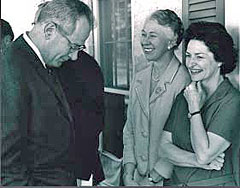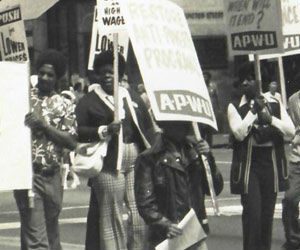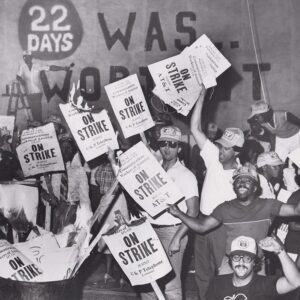April 30, 2009
Esther Peterson: Advocate for Labor, Women, Consumers
Throughout her life, Esther Eggersten Peterson was “a powerful and effective catalyst for change,” notes a tribute to her in the National Women’s Hall of Fame. Among other achievements, she helped launch the women’s movement in the 1960s and was considered by many to be the driving force behind the equal-pay movement.
Unusual Evolution
Peterson’s life as a workers’ advocate had an unlikely beginning. Raised in a conservative Mormon household in Provo, UT, Esther Eggersten had been led to believe that unions were evil, as those around her strongly opposed a railway workers strike in 1918, when she was 12. But she was also raised to try to help others, she recalled in a 1995 interview, and to “Do what is right; let the consequences follow,” as her church taught.
Peterson graduated from Brigham Young University in 1927, then moved to New York City, where she earned an advanced teaching degree at Columbia University and met Oliver Peterson. They married and moved to Boston, and in 1932 she was teaching at a prep school for well-to-do girls. She also had a second job, as a volunteer at a YWCA, where she taught classes for garment workers.
One evening, most of her YWCA students failed to show up. Wondering why, Peterson discovered that they were staging a job action, and had gone on strike after their employer changed the style of a women’s pocket from square to heart-shaped. The new design took much longer to sew, but the company refused to increase the “piece rate.”
At first, Peterson though the strike was a terrible idea. “I was raised thinking that [strikers] had bombs in their pockets and were communists.”
But Peterson cared deeply for her students. Her visit to the home of one young woman revealed that it was basically a sweatshop, with her student’s family, including young children, gathered under a single dim light, doing garment work. “The women had been making housedresses, a dollar- thirty-two-cents a dozen,” she told Common Cause magazine in 1995. “They couldn’t live on what they were making… It made me furious.”
It was during that very visit that Peterson became “a real labor activist,” she said. “I knew that the fathers of the kids at the prep school were the ones that were doing the exploiting. Their kids would come to school with chauffeurs in the morning, and [their fathers] couldn’t pay a minimum wage? Come on!” she said in a National Public Radio interview in 1993. “I decided they had to have a voice, the working people. I felt the women were left out, they got the low end of everything.”
The ‘Heartbreakers Strike’
The day after visiting the student’s home, she joined the workers on the picket line for what became known as the “Heartbreakers Strike.” Peterson organized others in the community into the Citizens’ Committee of Concerned Women, which helped the workers win the concessions they sought — no small accomplishment during the Great Depression.
Peterson continued teaching and began spending her summers instructing classes for the International Ladies’ Garment Workers’ Union, at the ILGWU’s Summer School for Women Workers in Industry, an experiment that brought young women from factory floors to the affluent setting of Bryn Mawr College, near Philadelphia. Seminar topics ranged from poetry to economics to birth control, and featured guest speakers such as Eleanor Roosevelt and W.E.B. DuBois.
“It was the most wonderful educational project I’ve ever been involved with,” she said. “We built the courses around [the women’s] lives.” The point was that “history didn’t just happen to you, it was up to you to change it.”
“I’m not one who feels that you have to be brave and be a star, but your life can be satisfying and happy if you work to make a difference. Maybe the difference will be just a little tiny piece. But the point is to make a difference by the way you live your life.” — Esther Peterson
Union Work
In 1938, Peterson became an organizer for the American Federation of Teachers. When she had the first of her four children that year, she experienced first-hand the difficulties of balancing the demands of work and family. She also discovered that the cost of daily child care often exceeded the wages paid to women in the jobs typically available to them, such as being a teacher.
In 1944, Peterson moved to Washington and became the Amalgamated Clothing Workers Union’s first female lobbyist. She fought for legislation to strengthen the Fair Labor Standards Act, which was enacted in 1938 and established the federal minimum wage, and also regulated overtime pay and child labor.
In 1948, Oliver Peterson went to work for the State Department and the family moved to Sweden, where Esther Peterson became active in the women’s committees of the Swedish Confederation of Trade Unions and the International Confederation of Free Trade Unions.
She became the AFL-CIO’s first woman lobbyist when the family returned to Washington in 1957. In 1960, she took a time off to work on the presidential campaign of Sen. John F. Kennedy, whom she had known since 1947, when she was the ACWU’s liaison to the newly elected U.S. representative from Massachusetts.
A Voice for Working Women
In 1961, President Kennedy appointed Peterson as Assistant Secretary of Labor, and as Director of the Women’s Bureau, which administered gender-issue labor laws.

Among other achievements, she led the successful campaign to pass the Equal Pay Act of 1963, a groundbreaking law that established the principle of equal pay for equal work, regardless of gender. (Women’s salaries have risen dramatically since the law’s enactment, from 62 percent of men’s earnings in 1970 to 80 percent in 2004, according to the Bureau of Labor Statistics. Union-backed legislative efforts to further close the gap continue. )
At Peterson’s urging, Kennedy created the Presidential Commission on the Status of Women. To chair the panel, she selected Eleanor Roosevelt, whom Peterson credited for being the main force behind women’s movement. “Eleanor taught us you could do things; she helped lead the way,” Peterson told Common Cause. “We stopped just licking the stamps and started getting into the decision-making.
Peterson hosted hearings across the country on the problems of working women, including equal pay, the glass ceiling, and the combined burden of race and gender discrimination faced by women of color. Her work resulted in a widely publicized report that helped advance child-care quality and availability, pay equity, and the fight against race and gender discrimination in the workplace.
The highest-ranking woman in the Kennedy administration, Peterson subsequently served as Assistant Secretary of Labor for Labor Standards, where she vigorously enforced wage, work-hour, and health and safety protections.
Consumer Advocate
After Kennedy was assassinated, Peterson became President Johnson’s special adviser for Consumer Affairs, leading the successful fight to improve food labeling. For the first time, products had to list their ingredients and nutritional value, show a “per unit” price, and display freshness-expiration dates.
Peterson later served in a similar role for President Carter. Her work in helping consumers make better informed purchasing decisions resulted in Carter awarding her the Presidential Medal of Freedom.
A widely respected activist, she was a board member for numerous consumer organizations and companies, with her public service career continuing well past retirement age. In 1993, President Clinton named the 87-year-old Peterson as a delegate to the United Nations General Assembly. She died Dec. 20, 1997.



